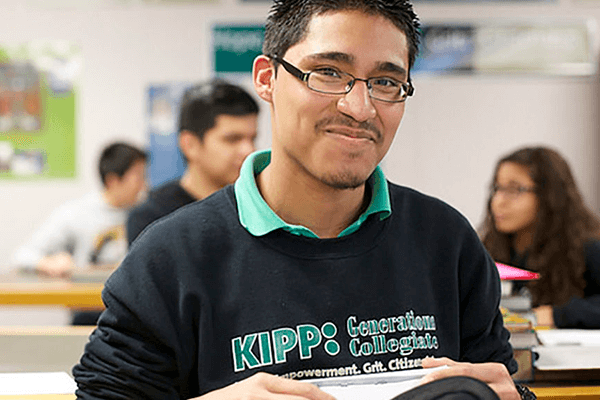KIPP’s Inspiring Approach to Supporting Their K-12 Community Through Change
ByMaria Alcon Heraux and Michelle BruceK-12 schools are so much more than a place for learning. They play a critical role as pillars of the communities in which they serve, providing students with structure, safety, and food. During this unprecedented time, K-12 leaders are faced with unique challenges as they transition to remote learning environments and support students, families, teachers, and staff in a whole new way.
Maria Alcon Heraux and Michelle Bruce from the Knowledge is Power Program Foundation, known as KIPP, shared how they’re supporting their 242 school communities nationwide as they navigate the impact of coronavirus.

A KIPP student in class. The KIPP Foundation is supporting their students, alumni, and community through the COVID-19 pandemic.
What are the biggest challenges you’re facing right now in this current environment?
Our initial priority was to ensure our students have access to meals daily. We’ve been delivering more than 150,000 meals across our schools nationwide, which have all been closed to prevent the spread of COVID-19. Nearly 90% of our students are eligible for free and reduced lunch so we’ve set up daily grab-and-go meals for our families as well as pantries in some regions so they can get access to food. We then moved on to ensuring our students have the technology and broadband internet needed to make remote teaching easy at scale.
How are you supporting both students and teachers as you transition to remote learning?
Launching remote learning, in some cases within 24 hours of school closures, certainly tested our resolve. We first surveyed our families to learn more about their needs. Then our schools rushed to send thousands of devices and instructional packets home to students and their families. In KIPP Texas alone, we’ve distributed 11,000 Chromebooks to students and launched an online portal to continue instruction from home. Our KIPP ENC schools in rural North Carolina have no other choice but to deliver 2,100 instructional packets every two weeks to students via school bus and pick them up for teachers to review. The majority of their students don’t have access to internet or devices so teachers are posting videos on YouTube or Facebook, which families can access on smartphones.
Throughout the network, special education case managers are connecting with the families of students who have an Individualized Education Plan (IEP) to ensure that at-home schooling is aligned with each child’s goals.
And our STEM team started the Create at Home Challenge with weekly prizes to incentivize KIPP and other students to create, innovate, wonder, and stay curious at home. Students have been building roller coasters, using an online design program to animate their name, participating in a robotics challenge, and conducting research.
How are you supporting the additional needs of your communities during this time?
In addition to providing grab-and-go meals, KIPP NYC teamed up with Food Bank NYC to set up a food pantry for families and members of the community. And just last week they received a delivery of 192 gallons of milk, 900 dozen eggs, 768 boxes of pasta, and more.
Our KIPP Texas staff mobilized a team to reach out to over 600 students who are currently homeless, ensuring they have access to food, shelter, and technology so they can learn and thrive. Science teachers in KIPP New Orleans, KIPP Massachusetts, and KIPP NYC have gathered science gear to donate to local hospitals to help first responders. KIPP Columbus raised $50,000 in grocery gift cards to distribute to our families. And in KIPP Minnesota, our staff is providing care for the children of first responders so they can focus on taking care of the sick.
Our team has also set up a KIPP Alumni Fund to help the thousands of alumni stranded at closed colleges around the country. We raised more than $140,000 so far and distributed more than 215 grants for assistance.
All of our teams have been creating and compiling an open resource library to help with academics, strengthen teams, guide leaders, and support students and families. We’ve always believed in sharing what we know.
What’s your communications strategy for sharing news and updates with teachers and families?
Many of our regions are using Google Classroom for instruction and utilizing social media and regular internal channels to connect with families. Our strategy has been to be caring, transparent, informative, and to communicate often.
Social media has been the connection to our students and families–from morning messages on Facebook to Storytime on Instagram to full lessons (from reading to exercise) available online. We’ve always had a deep connection with our families at KIPP as they are partners in our learning, but this pandemic has pushed us to do more on social media like dancing videos or asking them to share photos from learning at home.
Read the full article here
